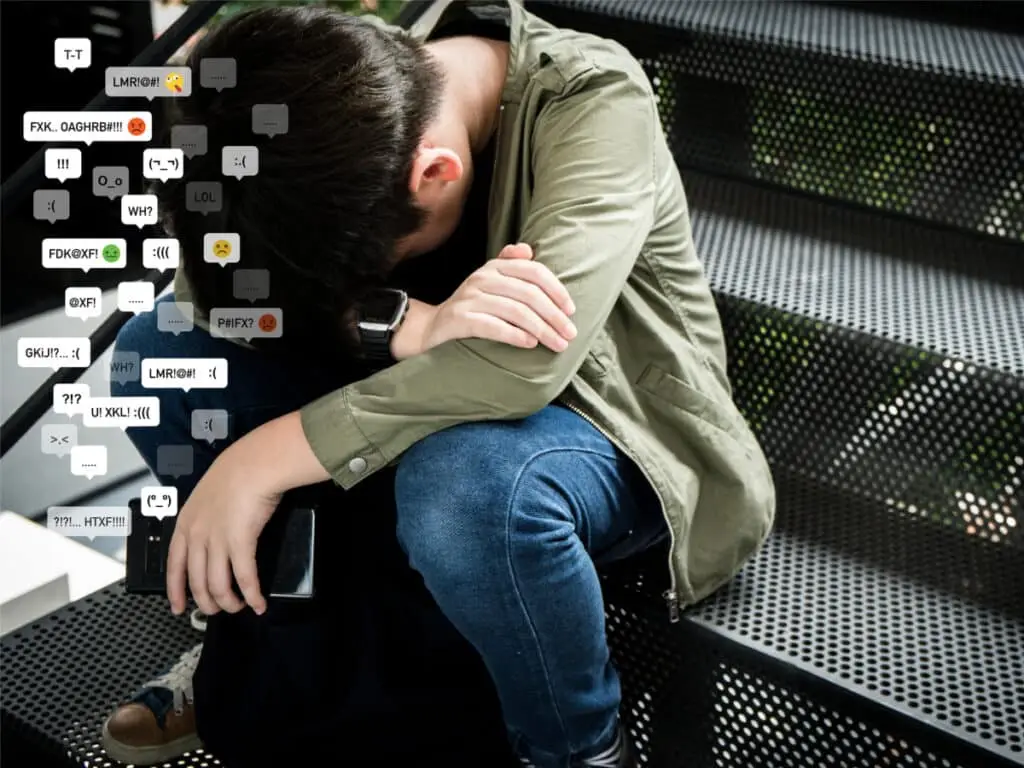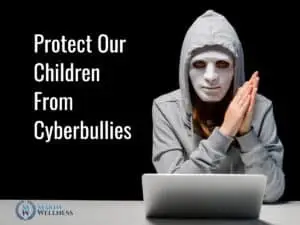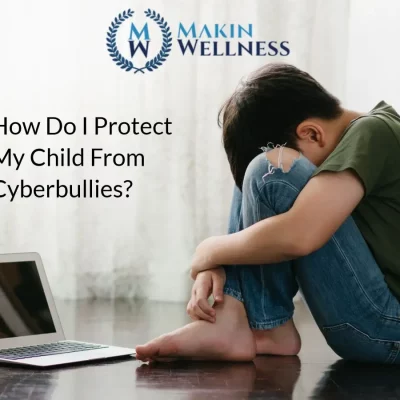You may think you know what your children are doing online. You may think you know exactly who they are talking to. Even so, there could be something darker happening under the surface.
In the year 2021, 60% of teenagers have reported experiencing some kind of cyberbullying.

If you’re a parent of children or teenagers, it’s natural to have concerns about this quiet virtual menace. Cyberbullying is a widespread problem that grows into a bigger challenge as technology finds new ways to connect us all. But what is cyberbullying?
If you are wondering about the effects of cyberbullying, and how you might help a child who is struggling, you’re not alone. Read on to learn everything you need to know in this guide to cyberbullying for parents.
What Is Cyberbullying?
For those of us who didn’t grow up in a world in which there was a smartphone in every hand, it can be difficult to understand exactly what it means to be a digital native. Digital natives are those who grew up in a world with the internet. They have never experienced a world without email, text messaging, video chats, voice chats, and more.

For our youngest children, especially those who may have experienced a year of virtual school, digital communication is another way of being together. Virtual spaces, while intangible, lend an air of privacy. Our children understand which messages everyone can see, and which are for friends’ eyes only.
Imagine a native guide in a land full of rough terrain. As visitors to the land, we would stumble and get lost. Our children, the native guides, recognize that, and their ability to exploit what adults understand is where cyberbullying begins.
Teens don’t fumble when taking screenshots of photos or incriminating text messages or social media posts. Even things that have been deleted can resurface.
It’s so easy for teens to take surreptitious videos, photos, or audio recordings without the consent of their peers. These embarrassing, upsetting or incriminating relics of past mistakes can spread fast. It is easy to lose track of how far a single humiliating photo has traveled.
Examples of Cyberbullying
Imagine two teens text messaging back and forth, either on their phones or on another social media app. Imagine that your child says something that any teenager might say to another when they believe the conversation is private. For example, your teen could admit to a crush on a teacher.

All the other teen has to do is take a screenshot with their phone, and send it to a group chat. That message has now made its way into a dozen households like a modern whispering campaign. From there, any of those teens can forward the message, turn it into a meme, or create social media videos mocking your child by name.
This can follow your child to school, where bullying can continue in person. Imagine how this grows more complicated if the teacher your child has a crush on is a teacher of the same sex. An innocent comment becomes ammo for targeted hate that can lead to physical altercations.
In another scenario, your child’s crush is on a young teacher. Rumors can spread that something physical has happened between the two. Your teen is then labeled with hateful words referencing promiscuity, which can lead to further trouble.
Other Examples
Digital natives are clever, and even know how to edit images and screenshots to put words in children’s mouths. They might bait your child until they are lead to say something that might be incriminating. They could even fabricate an entire interaction that your child may know nothing about.
Some cyberbullying begins in person, in the school cafeteria, or even the playground. Any child who is different might become the target of mocking online because of the way they look, dress, speak or act. Often these children are already isolated, and feeling as though they are a target can hurt their self-esteem further.
The text message described above could be a photo or video taken during your child’s worst moment. . Reliving that moment, again and again, can be humiliating and damaging. Something as innocent as throwing up at school, being unprepared for a menstrual period, or crying at the end of a rough day can all become the start of cyberbullying.
Think about all of the social media apps and online spaces with messaging capabilities. Every single one provides an opportunity for a bully to reach out to your child when they are least expecting it. If the same group of bullies is inundating your child with messages on every platform, it can feel like the world is ending.
Bullies can do more than fling insults. The most nefarious cyberbullies might encourage children to take their own lives. Children in marginalized groups are at higher risk of receiving such messages.

With hate and intimidation coming from every direction, kids can experience depression, anxiety, and more. This can lead to ongoing issues with self-esteem and mental illness.
The worst part is that it is so easy for all this to be going on without any adults realizing it. Embarrassed children or teens might not speak up, or feel like they can handle it themselves. This allows the problem to grow, and victims to suffer for a long time before parents and teachers have any idea.
Signs of Cyberbullying
Cyberbullying is easy to keep a secret. This makes it more important that parents pay careful attention to their children’s behavior.
This doesn’t mean becoming helicopter parents! Your teen still needs and demands a level of privacy and independence, so you must strike a balance.

Think about yourself when you were a teenager. If your parent or guardian showed up in the school cafeteria and began listening in on your conversations with your friends, you wouldn’t be happy! That’s what spying on social media can feel like to our digital natives.
Parents who notice the initial signs of a problem are more likely to be able to intervene in an appropriate and respectful way. These proactive parents can get their children help and relief and stop the problem. The first step is noticing the signs.
Changes in Social Behavior
A lot of cyberbullying can begin within your child’s peer group, or even with close friends. Take notice if your child is no longer spending time with other kids in the same social circle. Are they avoiding a certain group or place that they usually like to go?
When social kids begin isolating themselves, it’s a good sign that something is going on beneath the surface. Children experiencing cyberbullying might begin spending more time at home or in their bedrooms. They may be trying to “handle” the situation quietly, spending all of their social energy on putting out virtual fires.
School Struggles
Children experiencing cyberbullying may literally be losing sleep over it. If not, they may struggle to focus in school because they feel like they must watch their backs at all times. After school, they may struggle to focus on homework, and grades may suffer.
Children who once loved school might feign illness, or ask to stay home. Older teens may be truant or fail to report to school at all. Even if they attend school during the day, kids may avoid clubs, sports, or afterschool activities.

Mood Changes Surrounding Technology
If your phone-loving child gets angsty when they switch on the screen, it might be a sign that something untoward is happening in their virtual world. Changing attitudes surrounding technology can tip parents off that all is not well in their teen’s digital paradise.
Likewise, new, secretive behavior surrounding technology can be a major clue. Do they seem to be fiercely guarding their screens whenever anyone else comes near? Do they close internet windows or apps as soon as they hear you coming?
Children who seem to be hiding something may genuinely have something to hide. For some teens, this might mean avoiding or shutting off their phones or tablets altogether. If your tech-loving child has forsaken screentime, it’s a good idea to check in.
Soft Signs of Mental Illness
Depending on the length and severity of the bullying, some teens may begin to show drastic behavior. Some teens may begin experiencing signs of depression. They may talk about how life is meaningless, or stop taking care of their physical appearance.
Other children might express suicidal ideation. This does not necessarily mean that your child has a plan or will go through with it. It is, however, a sign that their quality of life is being affected in a major way that you should address with care.
Teens may also begin using or abusing substances, such as drugs and alcohol, to cope with challenging feelings stemming from cyberbullying. If you notice this behavior in conjunction with other behavior discussed, it is definitely time to take action.
How to Stop Cyberbullying
Once you notice these signs, your impulse will be to put an end to your child’s pain immediately. At this stage, it is more important to be thoughtful rather than impulsive. If you are wondering how to end cyberbullying and get your happy child back, there are steps that you can take.

Active Listening
If your child comes to you to discuss the problem, make sure you listen to what they are trying to communicate. Although teenagers can be dramatic, recognize that the pain they are feeling is real and valid. Try to put yourself in their situation and recognize the many complex dynamics at play.
Validate and Make a Plan
It is important to validate your child’s feelings and experiences. Make sure your child feels heard and understood.
You should also include your child in the process as you move forward. Ask your child what he or she needs to feel safe at home, at school, and in virtual spaces.
Collect Evidence
Before you begin blocking classmates and deleting apps, make sure to gather evidence of the bullying. Every message, screenshot, and video can be used to validate your child’s experience. You’ll want to collect everything you can find, with times and dates included whenever possible.
At that point, you can begin to block the bullies on as many platforms as possible.
Make the Appropriate Reports
Most schools have a handbook that outlines the school’s policy on cyberbullying. Consult this information. You can then take your evidence to the school administration, if applicable.
If cyberbullying has been taking place on a certain app or platform, you can often report it to the provider. If it violates the app’s terms and services, the provider can remove the bully from the platform.
In any situation in which there were threats of violence, you should take your evidence to the police.
This all may be embarrassing to your child, but there must be consequences for the inappropriate behavior.
Consider Therapy
When dealing with difficult emotions and social situations, a trained therapist can help your child to process. Giving your child a safe space to understand what happened can be invaluable. A therapist can help your child develop strategies that can help them safely reengage in social scenarios.
A therapist can help to validate your child’s experience and will show that you are taking their pain seriously.
End Cyberbullying For Good
The effects of cyberbullying can be intense for many children and teens. Understanding exactly what is going on, as well as why it is damaging, is a great way to serve as an ally for your child.

If your child has not yet experienced cyberbullying, now is the time to be proactive. Make sure they understand how to be safe online, and when to go to an adult. If they ask “What is cyberbullying?” you are now prepared to have that conversation!
If your child is struggling, the team of therapeutic practitioners at Makin Wellness would love to help. Our therapists are trained in working with children and teens. If you are concerned about your child’s mental health, contact us today to make an appointment.









This Post Has One Comment
This is one of the downsides of technology. Mental health is essential, especially for our children. I think it is really important to have constant communication with them.